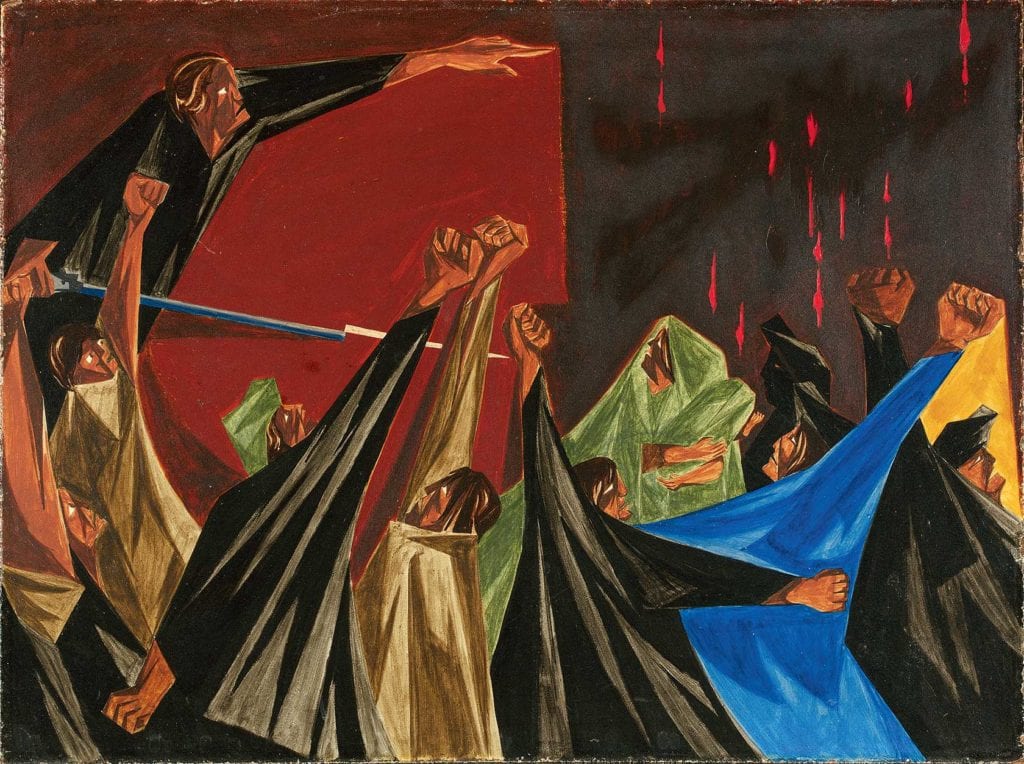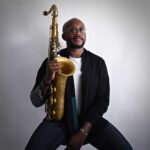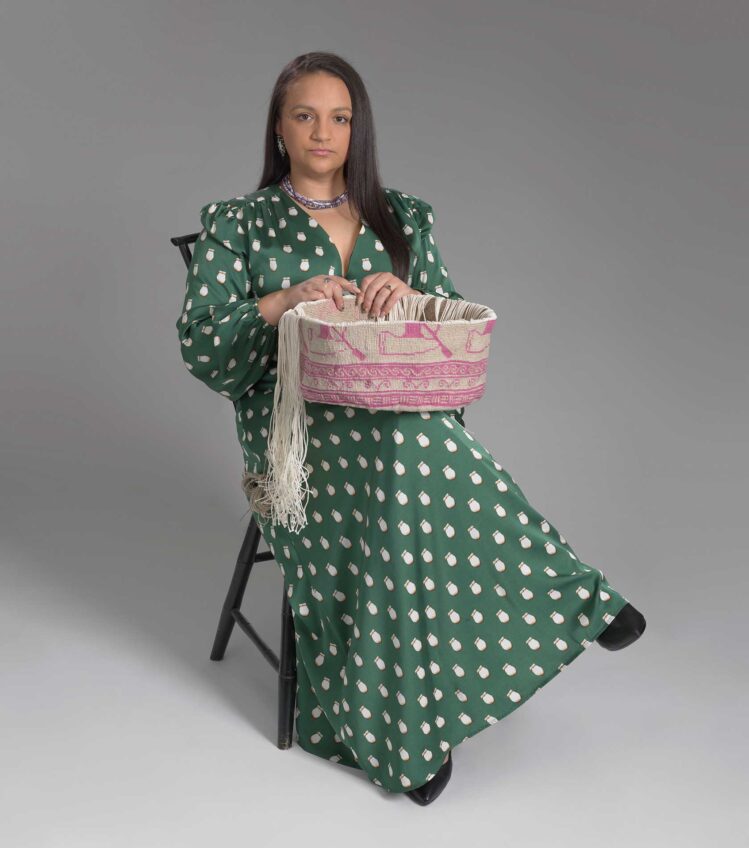
As Americans prepare to elect their 46th president, there could be no better time for the exhibition on view now through April 26 at the Peabody Essex Museum in Salem and then touring nationwide. Entitled “Jacob Lawrence: The American Struggle,” the exhibition reunites for the first time in 60 years the series “Struggle: From the History of the American People” (1954-56), a powerful portrayal of democracy-in-the-making by Jacob Lawrence (1917-2000), one of America’s most important modernist figurative painters.

Artist Jacob Lawrence with panels 26 and 27 from Struggle: From the History of the American People, 1954–56. ©Robert W. Kelley/The LIFE Picture Collection/Getty Images
The taut, cubist-inflected panels, each accompanied by captions Lawrence chose from historic documents, give voice to the overlooked whose sacrifices and diligence enabled the colonies to become an independent, self-ruled nation.
But the series does not only look back: Lawrence reimagines actual episodes of American history — from the Revolution to the War of 1812 and early westward expansion — as present-tense dramas that challenge viewers to see themselves in the ongoing struggle to create a democracy with opportunity for all, not just for a privileged few.
“The paintings which I propose to do will depict the struggles of a people to create a nation and their attempt to build a democracy,” Jacob Lawrence wrote in 1954.
Organized by PEM, the current exhibition is co-curated by Elizabeth Hutton Turner, professor of modern art at the University of Virginia, and Austen Barron Bailly, former PEM curator of American art and now chief curator at the Crystal Bridges Museum of American Art, and coordinated by PEM Assistant Curator Lydia Gordon.
Touring coast-to-coast through 2021, “Jacob Lawrence: The American Struggle” will visit the Metropolitan Museum of Art, the Birmingham Museum of Art, the Seattle Art Museum, and the Phillips Collection in Washington, D.C.

Jacob Lawrence, We, the people of the United States, in order to form a more perfect Union, establish justice, insure domestic tranquility . . . —17 September 1787, Panel 15, 1955, from Struggle: From the History of the American People, 1954–56, egg tempera on hardboard.
Harvard Art Museums/Fogg Museum, Francis H. Burr Memorial Fund, Richard Norton Fund, Henry George Berg Bequest Fund, Anonymous Fund in memory of Henry Berg, and Alpheus Hyatt Fund. © The Jacob and Gwendolyn Knight Lawrence Foundation, Seattle /Artists Rights Society, New York
Raised and educated in Harlem, Lawrence began chronicling the African American experience at age 20 with narrative series that combined tempera-on-board paintings, each 12-by-16 inches and each paired with a caption. Using this format, he created biographies of such anti-slavery champions as Toussaint L’Ouverture, Frederick Douglass and Harriet Tubman. His protagonists were always on the move, striving toward freedom and justice.
At age 23, Lawrence produced a series that was immediately recognized as a masterpiece, his 60-panel “Migration Series” (1940-41), an epic rendering of the African American exodus from the Jim Crow South to pursue opportunity in the North. In 1942, the Museum of Modern Art and the Phillips Gallery jointly purchased the work, the first by an African American to enter the then-segregated mainstream art world.
Lawrence envisioned “Struggle” with a perspective honed by his World War II experience. He served as a combat artist on the Navy’s first integrated troop carrier, which he described as “the best democracy I’ve ever known.” The panels in “Struggle” portray the endeavor of all Americans, not only African Americans, to build a democracy. Lawrence planned a 60-panel series, but in 1964, a decade after beginning the project, he ended the series with 30 panels. “Struggle” was last exhibited intact in a New York gallery in 1958.
Unlike “Migration Series,” an epic authored by Lawrence, “Struggle” renders actual events, and its captions quote eyewitness accounts. Lawrence drew the quotes from speeches, reports and letters he found at the 135th Street Branch of the New York Public Library in Harlem, home of the Schomburg Collection of Negro Literature, History and Prints (now the Schomburg Center for Research in Black Culture).
With an eye for the underrepresented, overlooked and unsung, Lawrence selected texts and rendered images that shed light on the resolve and sacrifices of ordinary men and women and people on the margins, including enslaved and indigenous Americans. “Struggle” portrays scenes of failure and loss, and even its images of heroism are free of triumph, always tempered by signs of recent violence and the wounds and hard-won cost of the struggle for independence. Drops of blood and the long, sharp lines of drawn swords and muskets are visible in almost all the panels.
Panel 12, with the caption “And a Woman Mans a Cannon,” shows a little-known heroine, Margaret Cochran Corbin, in action, as on Nov. 16, 1776 in the Battle of Fort Washington she takes up her slain husband’s post in the firing line and takes aim with visible zeal. In contrast to her crouched figure, made more horizontal by the elongated point of her rifle, another female stands to the left, her long robe a horizontal column of muted browns that blend with the earth-toned background. Why does Lawrence include her — and make it easy to miss her?
Lawrence’s highly stylized renderings of historic scenes challenge the viewer and reward close examination. Portraying democracy-building as a physical struggle, they employ shard-like shapes and contorted angles that convey the raw immediacy and urgent energy of the endeavor. And instead of celebrating landmark events, Lawrence’s reimaginings of such episodes inject a sense of tension, uncertainty and unfinished business.
In organizing this exhibition, six years in the making, the curators set and achieved ambitious goals: to present the series as the artist intended it and to inspire reflection as well as further research. Their primary challenge was to reassemble the series, which had been separated and sold off. The fate of five panels is unknown. Of the 25 that are accounted for, PEM obtained half from the Collection of Harvey and Harvey-Ann Ross and borrowed others from a variety of private and institutional collections. The curators determined the original sequence of the panels and matched each with its caption by studying exhibition records as well as the artist’s own files.
The exhibition catalog, edited by Turner and Bailly, includes essays by scholars and artists and full-color reproductions of the panels, each accompanied with a brief reflection by a different contributor. Other sections are devoted to Lawrence’s research sources for the series, a chronology of its development and the artist’s handwritten notes on the back of some panels. Behind an image of Patrick Henry stirring up a crowd, Lawrence writes, “PROPHECY.” On the back of his scene of the Constitutional Convention, he writes, “CREATION.”
Perhaps the unfinished state of “Struggle” suits its potent message — that building a democracy is an ongoing endeavor that continues to demand our vigilance and informed participation.






